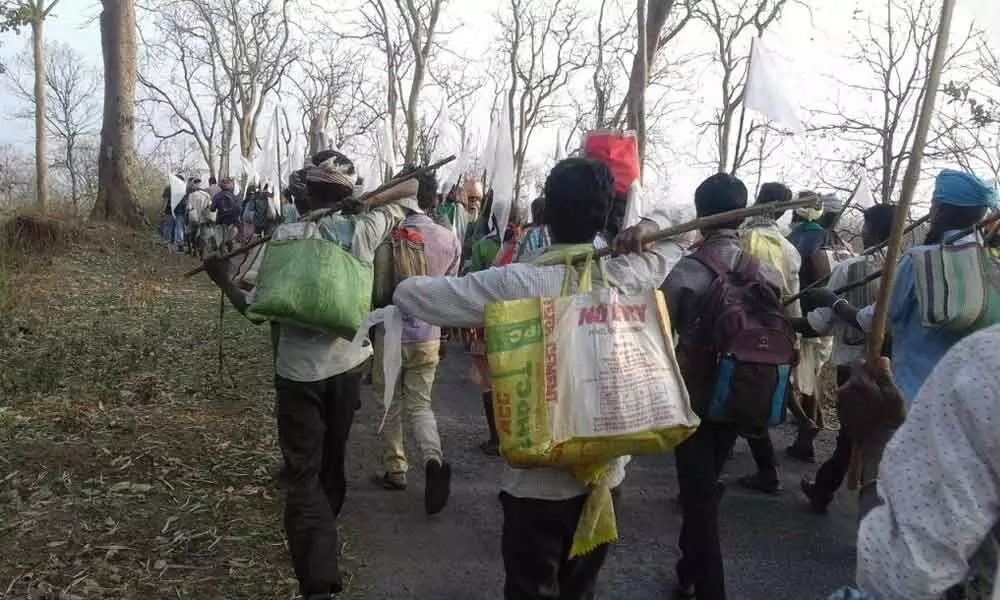New displacement threat for Adivasis in Madhya Pradesh

New displacement threat for Adivasis in Madhya Pradesh ( File Pic)
Yet another project in the country has come in for criticism by the Adivasis. This time around the National Alliance of People's Movements (NAPM), a top civil society network, has opposed the destruction of Buxwaha in a protected forest region in Madhya Pradesh’s Bundelkhand region for the proposed Bunder diamond mining project.
Yet another project in the country has come in for criticism by the Adivasis. This time around the National Alliance of People's Movements (NAPM), a top civil society network, has opposed the destruction of Buxwaha in a protected forest region in Madhya Pradesh's Bundelkhand region for the proposed Bunder diamond mining project. It has demanded that the government must immediately withdraw all projects which threaten the ecological and socio-cultural significance of Buxwaha.
The project, spearheaded by Aditya Birla Group's Essel Mining and Industries Ltd (EMIL), will lead to irrevocable destruction of dense forest land, including over 2 lakh trees. Pointing out that the government was making "the blatantly false claim that Adivasi communities are not dependent on the area", NAPM claimed at least 8,000 residents from more than 20 nearby villages rely heavily on these forests for their livelihoods and food security."
It is not uncommon for the governments to sacrifice natural resources and local communities for private profit. The project proposed now will be located in Chattarpur area of the State. The project, spearheaded by Aditya Birla Group's Essel Mining and Industries Ltd (EMIL), will lead to irrevocable destruction of dense forest land, including over 2 lakh trees. Local communities and citizens' campaigns are on to save Buxwaha forest. They are calling upon the State Government to scrap the project with immediate effect.
EMIL is currently in the process of obtaining regulatory clearances for a fully-mechanised open-cast mine and processing plant for diamonds on 364 hectares of protected forest land near Sagoria village. The project is expected to begin in 2022 and the company claims that it has the potential to be the biggest diamond mining plant in Asia. However, the mine will have devastating social and environmental effects on the Buxwaha protected forests and surrounding region. It will lead to the cutting of at least 2.15 lakh trees, severely threatening the region's rich biodiversity and the local Adivasi communities.
The project threatens critical wildlife habitats, including those of at least seven species listed in Schedule I of Wild Life Protection Act, 1972. It will also adversely impact the tiger corridor between the Panna National Park and the nearby Nauradehi forests of Bundelkhand. Moreover, Bundelkhand is drought prone and the water situation in the Buxwaha region itself has been declared as 'semi-critical'. The large water requirement for the mining project (1.6 crore litres per day) will lead to diversion of vital seasonal water sources found in the forests. Mining to depths of more than 1,100 feet will also severely deplete the already low groundwater levels.
The official version that says that no Adivasi community is dependent on the area is being debunked by the NAPM. However, at least 8,000 residents from more than 20 nearby villages rely heavily on these forests for their livelihoods and food security. Those critical of the present project feel that the experience from the Sardar Sarovar dam and other dam projects in the Narmada Valley shows that the MP government cannot be relied on to carry out proper 'compensatory afforestation' programs to compensate for the proposed destruction of Buxwaha forests. India should follow the example being set by some of the African countries in recognising nature as a legal right holder and protecting it.

















